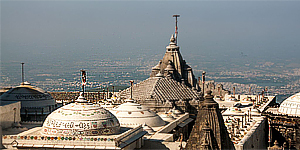 Shwetambar Jain Mahatirth, Girnar
Shwetambar Jain Mahatirth, Girnar Shwetambar Jain Mahatirth, Girnar
Shwetambar Jain Mahatirth, Girnar
Home > About Jain Temple at Girnar > Merkvasi Summit
Merakvasi summit
Situated on the right, just before the main temple of the Merakvashi summit is the Panchmeru temple.
 Panchmeru temple : (Lord Rushabhdev – 9 inches)
Panchmeru temple : (Lord Rushabhdev – 9 inches)
The construction of the Panchmeru temple is extremely elegant. There are five Merus2 in this temple representing the five of the highest peaks. At each of the four corners, four Merus - two of the Ghatki khand and two of Pushkaravard dveep(island) and in the center is the Meru of Jambudveep. On each of the five Meru’s, there are four idols, each facing one of the cardinal directions. Inscriptions have been found at this site which date the installation of these idols to Vikram Samvat year 1859.
The temple of Adbadji : (Lord Rushabhdev – 138 inches)
Upon exiting the Panchmeru temple and before entering the main temple of the Merakvashi summit, on the left is a gigantic idol of Lord Rushabhdev which reminds one of the Adbadji idol located in one of the nine summits of the eternal mountain, Shatrunjay. Since it is reminiscent of the Adbadji idol of Palitana, the temple here is also called the Adbadji temple. Despite being sculpted out of black stone, currently it has been coated in white. Non Jains refer to this idol as that of Bheem’s son Ghatotkach or Ghaghatuko. In front of this idol, is a yellow stone structure depicting 24 Tirthankar Lords along with an inscription dating its installation to the Vikram Samvat year 1468.
Upon exiting the Panchmeru temple and before entering the main temple of the Merakvashi summit, on the left is a gigantic idol of Lord Rushabhdev which reminds one of the Adbadji idol located in one of the nine summits of the eternal mountain, Shatrunjay. Since it is reminiscent of the Adbadji idol of Palitana, the temple here is also called the Adbadji temple. Despite being sculpted out of black stone, currently it has been coated in white. Non Jains refer to this idol as that of Bheem’s son Ghatotkach or Ghaghatuko. In front of this idol, is a yellow stone structure depicting 24 Tirthankar Lords along with an inscription dating its installation to the Vikram Samvat year 1468.
The main temple of the Merakvashi summit : (Lord Parshwanath with a 1000 snake hoods – 29 inches)
One is left awestruck looking at the architectural splendor and the array of fine chiseling on the domed ceiling of this temple, which is built up of concentric rings, reminding one of the Vimalvashi and Lunavashi temples of Abu. The main idol of Sahastrafana3 Parshwanath and many other idols in the 52 small temples surrounding it were consecrated in the Vikram Samvat year 1859,
Under the presence of revered Aacharya Jinendrasuri. Walking through the 52 temples starting from the left, one comes across a yellow stone on which the shrine of Ashtapad has been engraved with idols of the 24 Tirthankar Lords along with an inscription that dates it to Vikram Samvat year 1442. Further up in the center one can find the Ashtapad temple which is based on the 4-8-10-2 theme, meaning it has four, eight, ten and two idols in each of the four direction totaling to 24 idols thus recreating the theme of the original and divine Ashtapad shrine. Moving ahead you come across an idol of Lord Mahavir exactly behind the main idol. Further to the north, one is spellbound by the elaborate carvings in the ceiling of the smaller temples in the courtyard. Proceeding further, in the midst of several smaller temples, you see a large temple with a four faced idol (i.e. four idols in the four directions) of Lord Shantinath.
One is left awestruck looking at the architectural splendor and the array of fine chiseling on the domed ceiling of this temple, which is built up of concentric rings, reminding one of the Vimalvashi and Lunavashi temples of Abu. The main idol of Sahastrafana3 Parshwanath and many other idols in the 52 small temples surrounding it were consecrated in the Vikram Samvat year 1859,
Under the presence of revered Aacharya Jinendrasuri. Walking through the 52 temples starting from the left, one comes across a yellow stone on which the shrine of Ashtapad has been engraved with idols of the 24 Tirthankar Lords along with an inscription that dates it to Vikram Samvat year 1442. Further up in the center one can find the Ashtapad temple which is based on the 4-8-10-2 theme, meaning it has four, eight, ten and two idols in each of the four direction totaling to 24 idols thus recreating the theme of the original and divine Ashtapad shrine. Moving ahead you come across an idol of Lord Mahavir exactly behind the main idol. Further to the north, one is spellbound by the elaborate carvings in the ceiling of the smaller temples in the courtyard. Proceeding further, in the midst of several smaller temples, you see a large temple with a four faced idol (i.e. four idols in the four directions) of Lord Shantinath.
Based on Jain cosmology, Madhyaloka, where humans reside, consists of many continent-islands surrounded by oceans, the first few of which are Jambudvip – Lavan samudra; Ghatki Khand – Kalodadhi samudra, Pushkarvardvip – Pushkarvard samudra. Mount meru is at the center of Jambudvip. These are 2 additional Merus in the Ghatki khand and four more merus in the Pushkarvard dveep. However, since humans reside only in half of its meru (i.e. half of four = two) are considered totaling to five merus in all.
Sahastra means a thousand and fana means hood of the snake i.e. the one bearing hood of thousand snakes.
Sahastra means a thousand and fana means hood of the snake i.e. the one bearing hood of thousand snakes.